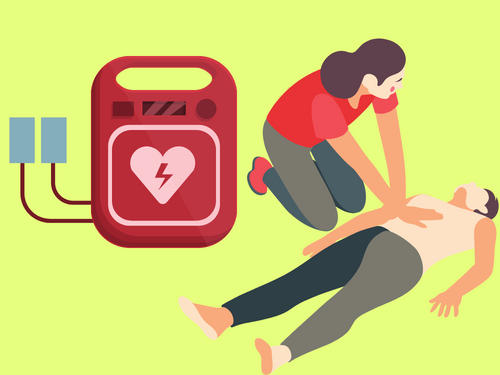Cardiopulmonary Resuscitation (CPR) and the Automated External Defibrillator (AED) are life-saving emergency techniques that significantly increase the chances of survival in a cardiac emergency. CPR is like a manual pump; it keeps the blood flowing with rhythmic chest compression. Meanwhile, the AED is your high-tech ally; it’s a portable device that delivers a life-saving electrical shock to jumpstart the heart into its normal rhythm.
CPR-AED certification prepares you to deal with any emergencies. Let us now go through the benefits of doing a CPR-AED certification together.
Understanding CPR and AED
CPR is a technique for maintaining blood flow when a person’s heart stops beating. It involves chest compressions to manually pump blood and rescue breaths to provide oxygen to the lungs.
An AED is a portable device that analyzes the heart’s rhythm and delivers an electric shock, if necessary, to restore a normal heartbeat. It is very user-friendly as it provides visual and audio prompts. Prompts help the common man to go through the defibrillation process with ease.
Importance of Certification
The need for certification in CPR and AED use cannot be overstated. Certification will build a sense of responsibility and preparedness for emergencies. The reasons for getting certified are:
- Increased Survival Rates: Studies show early CPR and defibrillation greatly increase survival rates in cardiac arrest cases. When you are certified in both, you can immediately intervene and save lives.
- Confidence and Preparedness: Training provides individuals with knowledge and hands-on practice to respond to emergencies. It is crucial to remain calm and take swift action in crises.
- Legal Protection: In some jurisdictions, laws protect individuals who provide emergency help, including CPR and AED use. Being certified can provide extra legal protection and assurance when providing aid.
Synergy of CPR and AED Training
The combination of CPR and AED training is critical in the response to cardiac emergencies. Combining these skills would better prepare individuals to manage life-threatening situations more effectively. The reasons for combining CPR and AED training are:
Complementary Skills
Training in CPR and AED is complementary because many cardiac arrest situations require the use of both. While CPR maintains blood circulation, an AED can restore a heart to a normal rhythm, thus improving the chances of survival.
Integrated Training Programs:
In most certification programs, CPR and AED training are commonly combined into one session, covering both skills comprehensively. Trainees learn to use their skills effectively using this integrated approach.
Efficiency and Effectiveness:
Getting certified in both CPR and AED together saves time and resources compared to taking separate courses. It has streamlined the process of training and also ensured that individuals are wholly equipped to handle cardiac emergencies.
Workplace and Community Benefits
CPR-AED Certification prepares one for life-saving skills. The advantages of workplaces and communities are:
Workplace Safety:
Many workplaces, such as offices, schools, and healthcare facilities, have installed AEDs. Certifying employees in both CPR and AED would ensure that the workplace is equipped to respond effectively to sudden cardiac emergencies.
Community Readiness:
Community organizations, such as sports clubs and churches, can train members in CPR and AED. This initiative broadens the network of trained responders in the community, thus improving overall readiness.
Public Access Defibrillation Programs
Certification in CPR and AED enables individuals to participate in public access defibrillation programs, where AEDs are strategically placed in public locations for immediate use by trained bystanders.
Special Considerations and Adaptations
As a CPR-AED trainee, you need to understand the differences and special needs of age groups. The important aspects to consider are:
Pediatric CPR and AED
Training in pediatric CPR and AED is recommended for individuals working with children. Children’s anatomical differences make CPR training different from those of adults.
Refresher Training
CPR and AED certifications need to be updated regularly to ensure that one’s skills remain current. Refresher courses provide updated information and reinforce proper techniques.
Virtual and Blended Learning
In the wake of COVID-19, many courses are now offered online. People can fulfill training and even become certified, all while keeping safe.
Wrapping Up
Investing in certification for both CPR and AED is a valuable investment in emergency preparedness. Individuals become equipped to respond to cardiac arrest incidents. Recognizing the importance of training in CPR and AED, it is always necessary to obtain certification in these two skills together. Investing in CPR-AED certification goes beyond personal preparedness; it demonstrates a commitment to public safety and the well-being of others.




